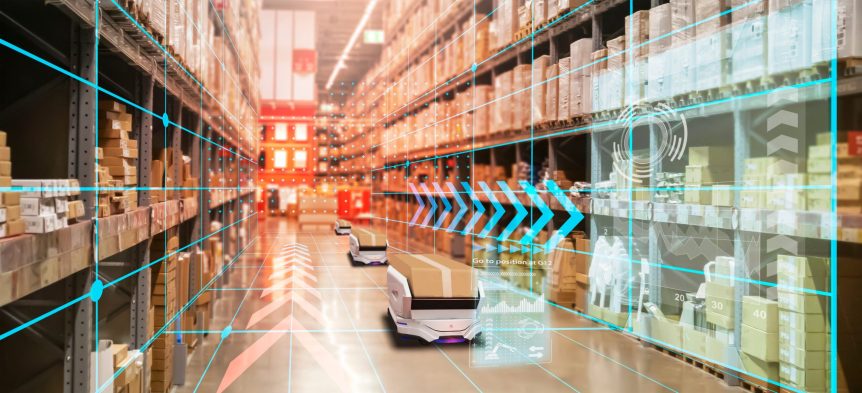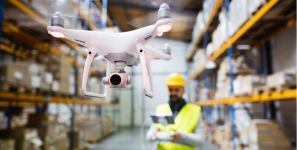Smart Warehousing Market: The Next Frontier in Logistics and Distribution
Introduction
Smart warehousing refers to the integration of advanced technologies into warehouse operations to enhance efficiency, accuracy, and responsiveness. This concept encompasses the use of automation, robotics, artificial intelligence (AI), and Internet of Things (IoT) technologies to streamline processes such as inventory management, picking, packaging, and shipping. Smart warehousing solutions enable real-time data analysis, predictive maintenance, and improved decision-making, significantly reducing human error and operational costs while increasing productivity.
Read also: Smart Warehousing Market to Surpass USD 122 Billion by 2036
According to Market.us, The projected valuation of the Global Smart Warehousing Market is estimated to reach approximately USD 78.6 billion by 2033, up from USD 20.3 billion in 2023. This reflects a compounded annual growth rate (CAGR) of 14.5% over the forecast period from 2024 to 2033. This growth trajectory underscores a significant expansion in the adoption and integration of smart warehousing solutions globally, driven by technological advancements and increasing demand for efficient inventory management and logistics operations.
The global smart warehousing market is experiencing substantial growth, driven by the increasing demand for automation across various industries, including e-commerce, manufacturing, and logistics. The market’s expansion can be attributed to the rising need for efficient inventory and warehouse management systems to handle large volumes of products and the growing consumer expectation for faster delivery services.
Read More @ Smart Warehousing : Enhancing Warehouse Operations
Despite the promising growth, the smart warehousing market faces challenges, primarily the high initial costs associated with implementing advanced technologies and training staff to operate new systems. Additionally, concerns about data security and the integration of technologies within existing infrastructure pose significant hurdles.
However, these challenges also present opportunities. There is a growing demand for smart warehousing solutions that can seamlessly integrate with older systems, offering substantial market potential for solutions providers. Furthermore, as businesses increasingly prioritize efficiency and reduced operational costs, the adoption of smart warehousing technologies is likely to expand, providing ample opportunities for growth in this dynamic industry.
In the dynamic landscape of logistics and supply chain management, smart warehousing represents a beacon of efficiency and innovation. By harnessing the power of technology, these facilities not only optimize storage and retrieval processes but also pave the way for a more agile and responsive supply chain ecosystem.
Smart Warehousing Statistics
- Market Size: The Smart Warehousing Market is poised for significant growth, with projections indicating a potential market size of approximately USD 78.6 billion by 2033. This represents a robust compound annual growth rate (CAGR) of 14.5% from its valuation of USD 20.3 billion in 2023
- Hardware Components: In 2023, hardware components were predominant, constituting over 51% of the market share. These components are crucial for capturing real-time data and facilitating automation within warehousing operations.
- Solution Deployment: On-premises solutions accounted for more than 56% of the market in 2023. This preference is largely attributed to the enhanced control, customization options, and reliability that on-premises systems offer to warehouse operators.
- Technology Application: Robotics and automation technologies were significant, holding more than 32% of the market share in 2023. These technologies are critical in driving operational efficiencies and addressing persistent labor shortages.
- Operational Focus: The order fulfillment segment captured over 34% of the market share in 2023, driven by the burgeoning demand for rapid and precise order processing, particularly propelled by the growth of e-commerce.
- Warehouse Size: Large warehouses accounted for the largest portion of the market at over 48% in 2023. The adoption of advanced technological solutions in large-scale operations is pivotal in managing more complex logistics tasks.
- Transportation & Logistics: This sector made up over 19.5% of the market share in 2023. Smart warehousing plays a vital role in optimizing supply chain operations, which is crucial for the efficiency and profitability of transportation and logistics companies.
- North America: In 2023, North America maintained a leading position in the global Smart Warehousing market, securing more than a 31.5% share. This dominance can be attributed to the rapid adoption of innovative warehousing technologies and the presence of major industry players in the region.
Emerging Trends in Smart Warehousing
- Automation Enhancement: The integration of Autonomous Mobile Robots (AMRs) and Automated Guided Vehicles (AGVs) is set to escalate, optimizing the movement and management of goods within warehouses without requiring fixed infrastructure. These technologies offer flexibility and adaptability to changing warehouse layouts and operations.
- Advanced Inventory Management: The adoption of sophisticated inventory tracking systems, including RFID technology, allows for real-time, accurate tracking and management of inventory levels, reducing errors and enhancing operational efficiency.
- Sustainability Initiatives: Warehouses are increasingly incorporating green practices, focusing on reducing the environmental impact through sustainable energy sources, waste management, and recycling processes. This shift is driven by global sustainability mandates and the need to reduce carbon footprints.
- Customization and Retrofitting: Old warehouses are being retrofitted to accommodate modern needs, particularly for specific industries like pharmaceuticals and automotive. This trend is toward making spaces more efficient and tailored to specific logistic requirements.
- Use of Wearable Technologies: Wearables are enhancing warehouse operations by improving worker mobility and efficiency. Devices like smart glasses and wrist-worn scanners help streamline processes by guiding workers directly to item locations, reducing the time spent on tasks and increasing accuracy.
Top Use Cases for Smart Warehousing
- E-commerce Fulfillment: Smart warehousing technologies streamline processes from inventory management to shipping, crucial for e-commerce businesses that require efficient handling and rapid delivery of a wide range of products.
- Pharmaceuticals: In industries where precision and compliance are critical, such as pharmaceuticals, smart warehousing ensures accurate inventory management, secure storage, and efficient distribution, adhering to stringent regulatory standards.
- Food and Beverage: Ensuring the quality and safety of food products, smart warehousing technologies manage the storage conditions precisely, tracking and maintaining optimal temperatures and environments for perishable goods.
- Automotive: For the automotive sector, smart warehousing facilitates the management of diverse parts and assemblies with high efficiency, supporting just-in-time manufacturing practices that reduce inventory costs and enhance production workflows.
- Retail: Integrating advanced technologies in retail warehousing helps manage a vast array of products and fluctuating supply demands, improving the accuracy of stock levels, and reducing overstock and stockouts.
Major Challenges in Smart Warehousing
- High Initial Costs: The initial investment required for advanced robotics, AI systems, and IoT integration can be prohibitively expensive for small to medium-sized enterprises, limiting their ability to adopt these technologies.
- Integration Complexities: Integrating new technologies with existing warehouse management systems presents significant challenges, requiring substantial changes to legacy systems and processes which can disrupt current operations.
- Skill Gaps: There is a significant skills gap in the workforce, as employees need to be trained to operate and maintain sophisticated warehousing technologies. This can lead to additional costs and delays in technology deployment.
- Data Security and Privacy Concerns: As warehousing becomes more reliant on data, the risks associated with data breaches and cybersecurity threats increase. Ensuring the security of sensitive information becomes a critical challenge.
- Regulatory and Compliance Issues: Warehouses must comply with numerous regulations, including safety, labor, and environmental standards. Adapting to these regulations while implementing new technologies can be complex and costly.
Market Opportunities in Smart Warehousing
- Growing E-commerce Sector: The continuous expansion of the e-commerce industry provides a significant opportunity for smart warehousing solutions to streamline fulfillment and improve delivery efficiency, meeting the increasing consumer demand for quick and accurate services.
- Need for Supply Chain Resilience: The recent global disruptions have highlighted the need for resilient supply chains. Smart warehousing can offer the agility and flexibility needed to adapt to changing market conditions, providing a substantial opportunity for growth.
- Technological Advancements: Continuous improvements in AI, robotics, and IoT offer new opportunities for warehousing operations to enhance efficiency and accuracy. Companies that can leverage these technologies effectively have a competitive edge.
- Sustainability Initiatives: There is a growing market for green warehousing solutions that minimize environmental impacts. Implementing sustainable practices can not only reduce costs but also appeal to environmentally conscious consumers.
- Customization and Retrofitting of Warehouses: As businesses seek to optimize their logistics to cater to specific industries, there is a rising opportunity for providing customized solutions and retrofitting existing warehouses to meet modern demands.
Factors affecting the growth of the smart warehousing market
The growth of the smart warehousing market is influenced by several key factors:
- Technological Advancements: Innovations in robotics, artificial intelligence (AI), and the Internet of Things (IoT) are central to the development of smart warehousing. As these technologies become more advanced and affordable, they facilitate more efficient operations in warehousing, driving the market forward.
- E-commerce Growth: The exponential rise in online shopping has significantly impacted the warehousing sector. E-commerce companies demand fast, efficient, and accurate warehousing operations to meet customer expectations for rapid delivery, thereby pushing the adoption of smart warehousing solutions.
- Labor Cost and Availability: High labor costs and a shortage of skilled workforce in warehousing have prompted companies to invest in automated solutions to reduce dependence on human labor while enhancing productivity and reducing errors.
- Supply Chain Complexity: Increasing complexity in supply chains, with more global sourcing and distribution channels, necessitates more sophisticated warehousing solutions that can manage complex logistics tasks more efficiently.
- Regulatory Compliance and Sustainability Pressures: Businesses are increasingly required to comply with strict regulations regarding safety, labor, and environmental standards. Smart warehousing can help in adhering to these regulations through improved tracking, efficient use of resources, and better safety mechanisms. Additionally, there’s a growing emphasis on sustainability, prompting warehouses to adopt greener practices and technologies.
- Demand for Real-Time Data and Analytics: There is an increasing need for real-time data to make quick and informed decisions. Smart warehousing facilitates the collection and analysis of data, improving inventory management, and operational decisions.
Market Dynamics
Driver: Growth of E-commerce
The expansion of e-commerce is a primary driver propelling the smart warehousing market. E-commerce has transformed shopping behaviors and business operations globally, facilitated by the widespread use of the internet and smartphones. This has increased the demand for efficient order processing and timely deliveries, which smart warehouses facilitate through real-time visibility and cloud-based warehouse management systems. These systems offer scalability and flexibility, allowing businesses to adapt to changing needs swiftly, thereby driving the smart warehousing market forward.
Restraint: Data Security and Privacy Concerns
A significant restraint affecting the smart warehousing market is the concern regarding data security and privacy. The interconnected nature of smart warehouses, filled with various sensors and smart devices, creates multiple vulnerabilities that could be exploited through cyberattacks. These potential security breaches could lead to unauthorized access to sensitive data or disrupt operations. Moreover, the storage and management of personal information about customers and employees necessitate strict compliance with data protection regulations, adding complexity and potential risks for businesses operating smart warehouses.
Opportunity: Integration of Advanced Technologies
The smart warehousing market is presented with substantial opportunities through the integration of advanced technologies such as AI, IoT, robotics, and blockchain. These technologies enhance the operational efficiency of warehouses by automating tasks like inventory tracking and order fulfillment, and providing real-time data analytics. The adoption of these innovations helps in minimizing errors, reducing labor costs, and improving overall service quality. As technology continues to evolve, warehouses that leverage these advancements can expect significant gains in productivity and competitiveness.
Challenge: Integration Complexity and High Initial Investment
The primary challenge for the smart warehousing market lies in the complexity associated with integrating new technologies and the high initial costs involved. Implementing sophisticated systems like automated guided vehicles, IoT devices, and AI-driven analytics requires significant technical expertise and financial investment.
The complexity increases with the need to ensure these systems are compatible with existing operations without disrupting daily activities. Additionally, the cost barrier can be particularly high for small to medium-sized enterprises, which may not have the capital to invest in such advanced technologies upfront.





Leave a Reply